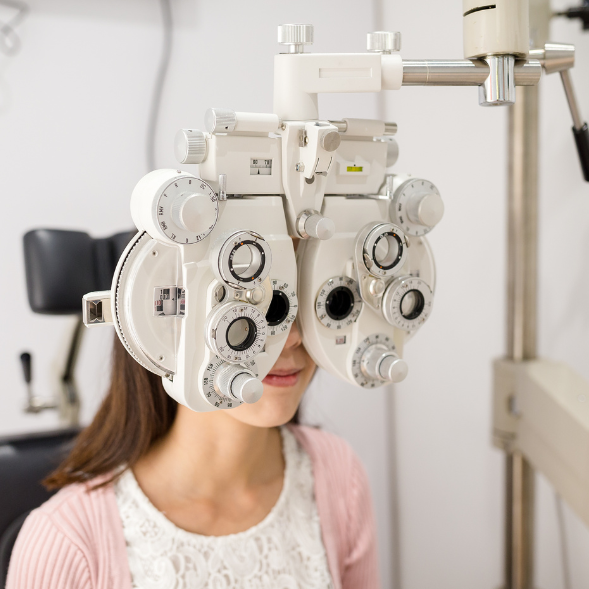At Family Eye Physicians, we are pediatric eye doctors with particular attention to patients with special needs.
We treat a wide variety of pediatric ophthalmology disorders including strabismus, amblyopia, congenital cataracts, blocked tear ducts, ptosis, retinopathy of prematurity, chalazia, and more. Our team of pediatric eye doctors stress the importance of routine eye exams to detect potential vision problems early in a child’s life.


Ocular misalignment prevents the brain from fusing images from each eye into a single image; this often affects depth perception and may result in double vision. In many cases, the brain will shut down or suppress visual input from the misaligned eye, causing potentially permanent vision loss (strabismic amblyopia).
Often referred to as “lazy eye”, amblyopia is a developmental brain phenomenon, where the nondominant or suppressed eye loses vision from disuse (much like a left-handed child gradually loses the ability to become proficient with the right hand).
Strabismic amblyopia: Some patients with eye misalignment may switch fixation back and forth between the two eyes; in others, one eye becomes “dominant” with the other, “non-preferred” eye potentially losing vision from disuse.
Refractive amblyopia: When the refractive error (glasses measurement) is very high or very asymmetric, one or both eyes may lose vision from being out of focus more or less continuously. Often, the eyes remain straight, so parents do not notice an outward deviation, and the dominant eye may retain normal vision, so parents may not realize that the amblyopic eye has lost sight.
Deprivation amblyopia: Amblyopia may also develop if normal vision is blocked (for example, by a droopy eyelid, cataract, or a dense scar) or otherwise distorted by structural problems (retinal diseases or optic nerve malformation). This type of amblyopia may be one-sided (as in a unilateral cataract) or affect both eyes (as in bilateral cataracts).
The tears produced by the lacrimal gland drain through a small eyelid opening near the base of your nose, then into the tear duct. This passage can be narrow or blocked, resulting in tear overflow. In infants, there is commonly an obstructing membrane will eventually open by four months of age. Massage of the tear duct may help push open the obstruction. Antibiotic drops may be used to treat the discharge and associated infection. If other therapies fail a probing of the tear duct may be performed in the office or in an operating room under anesthesia. If the nasolacrimal duct probing is done in the operating room, it is common to place a stent at the time of the procedure to reduce the reoccurrence.
Eye infections (Conjunctivitis) can be bacterial, allergic or viral; usually associated with discharge and a red eye. Symptoms may include tearing, itching, burning, light sensitivity and pain. Proper hygiene is important to reduce the risk of transmitting infections, particularly handwashing, avoiding touching the infected eye or sharing towels or pillows.
Headaches may be caused by a variety of eye diseases, including ocular inflammation, acute glaucoma, or convergence insufficiency which is a type of strabismus. These can be often treated with eye exercises. Headaches may be associated with visual symptoms, including blurred vision or seeing spots, even when there is no direct ocular cause. After confirming the absence of ocular disease, visual migraines may be managed by a primary care or neurologist in similar fashion as other migraine variants.
A chalazion or stye is basically a blocked oil gland, much like an pimple. As in facial acne, one or more chalazia may present on one or multiple eyelids, but they are not contagious. Occasionally warm compresses may help heat the oil inside the eyelid to help it drain. If persistent, draining the cyst may be performed as an in-office or operating room procedure.
Dilating drops allow the pediatric eye doctor to exam the inside of the eye, particularly the optic nerve and retina. In addition to enlarging the pupil, these drops reduce the ability to change focus, allowing the doctor to measure the refractive error (glasses prescription). Using dilating drops (cycloplegic refraction) is actually the most accurate method to check glasses prescriptions, and is especially important in children, who can otherwise change focus so easily. The drops blur the near vision for a few hours, while pupillary dilation generally lasts longer.
Our board-certified pediatric ophthalmologists and pediatric eye doctors use the most current, state-of-the-art equipment and methods to treat and diagnose your child’s vision and eye problems.
